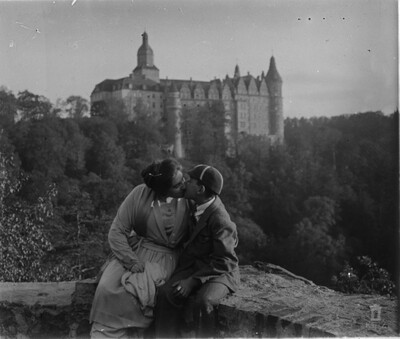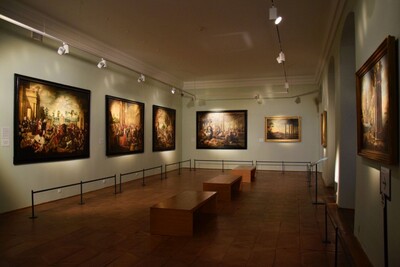The Wałbrzych Palm House arose from the initiative of the last representative of the Hochberg dynasty in Książ Castle, Hans Heinrich XV. The Prince had it built for his spouse, Mary Theresa Cornwallis-West, known as Daisy: a lover of beautiful flowers and original plants. To this day, this expression of love -- the largest imaginable “bouquet of flowers” -- holds great charm. It is the only such facility in Poland that has been preserved in its original construction.
The building of the Palm House is said to have taken place between 1908 and 1911, though some authors suggest 1911 to1914. The investment swallowed the astronomical sum of seven million marks of that time, in gold. On a surface of 1,900 square metres, apart from the Palm House, a greenhouse, a garden maintained in the Japanese style, a rose garden, a fruit and vegetable garden, and an area for the cultivation of shrubs were also developed. The whole undertaking was so immense that it became called a garden “factory”. As soon as the construction work was built, some 80 species of new plants were introduced to the Palm House.
The central part of the facility was a 15-metre building, constructed from metal and glass, in which date palms were planted. This was surrounded by one-storey conservatories. On the Palm House’s roof a small lookout was created, from which it was possible to admire the charming panorama of the surroundings. Still, most remarkable was the building material which lined the Palm House interior. The Prince had seven train wagonloads of hardened lava from the Etna volcano brought from Sicily. Large pieces of volcanic tuff were beaten into smaller pieces; from this were created grottos , waterfalls and a wall with plant pockets.
However, the rose garden was to remain the apple of the Princess’ eye. Among other species, roses with snow-white petals, today known as the “Daisy” variety, were cultivated. As soon as the Palm House came into existence, it was available to visitors. So fascinated was the Princess with roses that she recommended the development of a second large rose garden on the castle terraces. To this day, summer visitors to Książ Castle may walk through the Rose Terrace.
This is not all that the Princess changed in the castle gardens: to transform the appearance of the terraces and the surrounding park according to her particular vision, she brought gardeners from her native Great Britain. The gardens, maintained up to this time in an orderly French way, were refashioned according to an English style, characterized by natural and romantic qualities. There appeared a large number of rhododendrons, beloved by Daisy. The Palm House provided the seedlings of the bushes and other plants that served to change the decor of the castle surroundings. The Palm House was also the source of fresh vegetables and fruits for the princely kitchen.
At present, over 250 species of plants grow in the Wałbrzych Palm House, which represents flora from a variety of climate zones and continents. One may view bamboos, fig trees and bushes from Asia; eucalyptus, spruce and pine trees from Australia; perennials from Africa; cactus and agave plants from Central America; and Mediterranean citrus plants. As a special attraction for admirers of the Far East, there is Poland’s only Bonsai exhibition: a presentation of remarkable specimens of these miniature trees, which have won many awards in Poland and abroad. Such an exhibition is a true attraction for visitors: the oldest bonsai in the collection is a juniper whose age reaches to 200 years. The presentation of small trees allows visitors to see, in miniature form, the passing of the four seasons, corresponding to the weather conditions outside.
| Day of the week | Opening hours | ||
|---|---|---|---|
| Monday | 09:00 - 18:00 | ||
| Tuesday | 09:00 - 18:00 | ||
| Wednesday | 09:00 - 18:00 | ||
| Thursday | 09:00 - 18:00 | ||
| Friday | 09:00 - 18:00 | ||
| Saturday | 09:00 - 19:00 | ||
| Sunday | 09:00 - 19:00 | ||
| Holidays | Opening hours |
|---|---|
| 2025.04.20 (Sunday) | x |
| 2025.04.21 (Monday) | x |
| 2025.05.01 (Thursday) | x |
| 2025.05.03 (Saturday) | x |
| 2025.06.19 (Thursday) | x |
| 2025.08.15 (Friday) | x |
| 2025.11.01 (Saturday) | x |
| 2025.11.11 (Tuesday) | x |
| 2025.12.25 (Thursday) | x |
| 2025.12.26 (Friday) | x |
| Tickets | ||
|---|---|---|
| normal | 25.00 PLN | |
| reduced | 19.00 PLN | |
| when? | name | where? | about what? | for free | for children | |
|---|---|---|---|---|---|---|
 | A Gourmet’s View of Książ Permanent exhibition | Książ Castle ul. Piastów Śląskich 1 58-306 Wałbrzych Dolnośląskie | photography | |||
 | Metamorphoses of Książ Castle Permanent exhibition | Książ Castle ul. Piastów Śląskich 1 58-306 Wałbrzych Dolnośląskie |